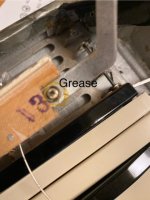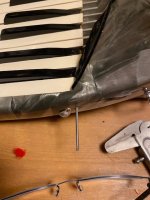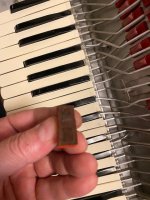MilkoTV
Newbie
Greetings!
I am repairing an old Elettra.
The treble keys are noisy and I believe the pallets need replacing.
Would you please advise about options:
Option 1: Removing the old 2 mm felt + 1 mm suede (turned out to be a tricky business) and replacing with new 2mm felt + 1mm suede.
Option 2: Gluing new 1mm suede on top of the existing old ones
Option 3: Gluing new sandwich of felt + suede (1mm felt +1 mm felt) on top of the existing old ones
Option 4: ? (besides giving up
Also, would you advice where in US one can find 1mm suede suitable for the task ?
(suede + felt I have sources for)
Thanks and regards!
I am repairing an old Elettra.
The treble keys are noisy and I believe the pallets need replacing.
Would you please advise about options:
Option 1: Removing the old 2 mm felt + 1 mm suede (turned out to be a tricky business) and replacing with new 2mm felt + 1mm suede.
Option 2: Gluing new 1mm suede on top of the existing old ones
Option 3: Gluing new sandwich of felt + suede (1mm felt +1 mm felt) on top of the existing old ones
Option 4: ? (besides giving up
Also, would you advice where in US one can find 1mm suede suitable for the task ?
(suede + felt I have sources for)
Thanks and regards!
Last edited:



